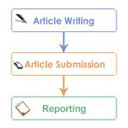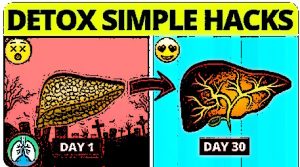
Here’s 5 simple Steps to Powerful Article Marketing for all internet marketer, practice it to promote your products and see the results yourselves 🙂
Today, article marketing is probably one of the most powerful and inexpensive forms of online marketing available to small business owners and non-profits. For those not savvy with the term “article marketing,” here is a quick definition:
In exchange for a little sweat and focus, an article author (you) shares their wisdom and experience with the world by posting their short article of advice or insight to blogs, social media, and article publication sites. Within those articles are one-way links leading back to the author’s own website, raising the website’s “authority” karma with the search engines and increasing qualified web traffic.

You Are the Expert
Here is a little mental preparation for you. I want to make sure you are looking at article marketing – and yourself – through the proper lens.
When you produce articles, it is your goal to encapsulate gems of experience-hardened wisdom and share them with the online community. In doing so, you:
1. Help to advise those who are seeking that knowledge, and you
2. Position yourself as an expert on the topic. (Important!)
Warning: Don’t get caught up on the term “expert.” Many humble folks who are vastly knowledgeable about their industry wouldn’t refer to themselves as experts because they are also aware there is much they don’t know. You don’t have to know it all. You just need to know more than your customers and then know where to find the answers when you are stumped.
Your Mission: Inspire, Inform, Entertain
Your primary goal in business is to help, right? Businesses and nonprofit organizations provide products and services with the intent of helping people. (Naive? Maybe. Choosing to see the best? Definitely.) That might mean helping to:
1. Provide a solution to a problem,
2. Offer inspiration, motivation or elevation,
3. Foster greater awareness to a social concern, or even to
4. Entertain and enthrall.
The best place to start? Begin with what you know. Offer advice. Offer your life experience. Offer sagacious words of wisdom. Expound and elucidate. Maybe even do a little research. Article marketing is your vehicle for taking your wisdom to your audience, answering their questions before their questions have bubbled up.
Step 1: Target Your Topic
What do you specialize in? What do you know a lot about? What is the point to your website? After all, the goal of any article marketing campaign is to place articles of value out into the world and grow your number of back links (links that point back to your website from another website.) Google and other popular search engines/directories see these links leading into your website as proof you must be something of an authority.
Translation: On the Internet, you are somebody important if other people say you are. It’s like high school all over again! Yeah!
Step 2: Write the Article
To begin marketing with articles, you must write the articles. No kidding. Sure, there is some work involved here, but the rewards can be great as qualified traffic to your website increases. Yes, I’m aware there are certain sources for pre-written articles on a myriad of topics, however I would recommend against putting your name on other people’s work. Call me paranoid, but here are some possible dangers with this:
1. Loss of credibility and damage to your reputation when it’s discovered you’re not writing your own material,
2. Being called upon to discuss a topic you barely considered to begin with, and
3. Being accountable for someone else’s errors if they pop up.
Remember: One of the greatest things about writing is the fact you’re building an asset when you write. You are building a body of reproducible and shareable knowledge. This is what “Rich Dad, Poor Dad” author, Rob Kiyosaki, refers to as “doing it once and replicating it over and over.”
To write an article, you don’t have to be a Harvard literature graduate, but you should know how to complete a thought, hold a one-way conversation with a friend, and use spellcheck.
* First, know what your goal is for your article. What is your point? Being clear on this will help keep you on track as you craft your introduction, body and conclusion.
* Next, pretend you are relaying this information to a friend. What would you say? How would you counsel this friend if they came to you seeking this advice?
* Finally, use spellcheck. Proofread, proofread, proofread. Read the article aloud to test for smooth flow and phrasing. Ferret out all typos, grammatical errors and punctuation gaffs. If missed, these mistakes can detract from your writing and credibility.
The Resource Box
The last detail you’ll consider for your article will be your resource box. Your resource box is the little paragraph at the end of your article that tells the reader a little about you and how to contact you. It should always include a link to your website. Always. You want your readers to be able to find you if they desire more information and you want the search engines to see you as an authority through that back link, remember?
Key point: In your resource box, you don’t always have to use the same link back to your website’s homepage. In fact, you will likely have greater success by linking to the page on your site most closely related to your article’s topic. This moves visitors from the article directly to their topic of interest. (For example, if a web design company also offers web hosting, their article “How to pick the best web host” should link back to the page on their website that describes their web hosting services.)
Step 3: Launch!
There! You have produced a shiny little gem of literary brilliance. Now it is time to set it free.
1. Place it on your blog (if you have one and if it fits appropriately).
2. Share it with Facebook, LinkedIn, Twitter and your other social media outlets. You can post it over and over by hand or use tools like PingFM to automate this process.
3. Submit your article to free article directories! Here are the top 10 most popular article directories, according to list of the top 50, found at:
http://www.vretoolbar.com/articles/directories.php
– knol.google.com
– ezinearticles.com
– ehow.com
– hubpages.com
– squidoo.com
– articlesbase.com
– buzzle.com
– associatedcontent.com
– suite101.com
– technorati.com
4. Use an article submission program or service to shorten this process. One good example is isnare.com.
5. Feeling brave? Record your article as you read it into a microphone and post it to iTunes.
6. Braver still? Use your digital video camera and post your work to YouTube and the like.
Step 4: Track Your Results
Just because you’ve accomplished the first three steps of deciding, drafting and delivering your article, don’t think you’re done! You should be watching to see how this article affects your traffic. Did you see an increase? Did your website’s conversion rate (the number of calls, emails, sign-ups, sales, etc.) edge up? If not, did your article compel people to want to know more? Did it provide enough value? Was it
placed properly?
Marketing Tip: Use the powerful and free traffic-tracking tool, Google Analytics. Design your
Analytics reports and schedule them to automatically arrive in your inbox as frequently as you like.
Step 5: Rinse and Repeat
Now do it again. Find different-but-related categories to place your articles under so they don’t complete with each other. Discuss different aspects of products and services you offer. Determine how often you will you produce and post your articles. This depends on how intensely you want to run your article marketing campaign. You’ll need to weigh your priorities against your normal day-to-day workload, your goals and the competitiveness of your industry.
If you’re just starting out, aim to write weekly or bi-weekly articles like the two-week promotional campaign in Step 3 suggests. If you are an ambitious writer or blogger, step up your efforts to daily and spread your articles across the media outlets.
Marketing Tip: Since you’re writing these articles anyway, you may as well post them to your website to keep your site’s content fresh. Then place them in your online newsletter and send them to your mailing list.
Afterglow
At this point, you have enough of a blueprint to successfully manage your own article marketing campaign. Writing articles can be a fun way to promote your website, but it can also be a great way to collect your thoughts and bring greater clarity to challenges you may be facing. Use articles to entertain, educate and inspire!
About The Author
Matt Schoenherr is a husband, father of four, business owner of Dreamscape Multimedia, and marketing consultant. As a syndicated author of a marketing and public relations column, Matt writes for a national online news magazine. Matt has over 17 years of national community outreach experience. His blog at www.mattschoenherr.com analyzes marketing concepts, delivers marketing ideas and occasionally explores the more magical side of life.
[tags]Powerful Article Marketing, Matt Schoenherr, Step by Step, Learning online Marketing, Massive internet traffic, Online Tip, Marketing online, Make Money online, Article marketing, Marketing Website, Free Online Traffic, IM, SEO, Marketing Mastery Series, 5 Steps, Massive Online Marketing, Internet Marketing, blogs, social media, Back Links Building[/tags]




